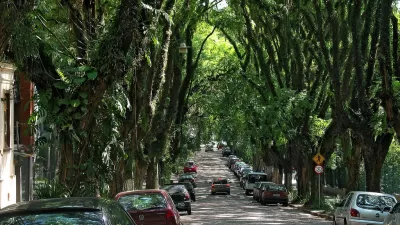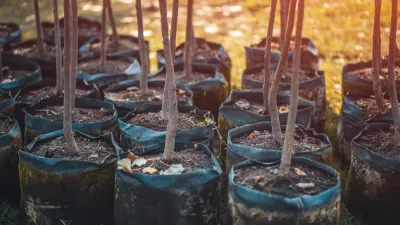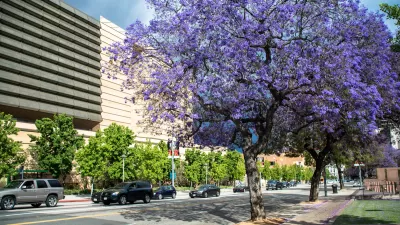New research reveals more of the details of how trees provide therapeutic effects for humans.

Alex Hutchinson writes of the larger implications of a new study published by the journal Scientific Reports into the nature of the therapeutic benefits of trees.
A team of researchers in the United States, Canada, and Australia, led by the University of Chicago psychology professor Marc Berman, collected two large data sets from the city of Toronto, according to Hutchinson, "both gathered on a block-by-block level; the first measures the distribution of green space, as determined from satellite imagery and a comprehensive list of all five hundred and thirty thousand trees planted on public land, and the second measures health, as assessed by a detailed survey of ninety-four thousand respondents."
The study's findings: "an additional ten trees on a given block corresponded to a one-per-cent increase in how healthy nearby residents felt." Berman is quoted directly to add perspective:
'To get an equivalent increase with money, you’d have to give each household in that neighborhood ten thousand dollars—or make people seven years younger,' Berman told me.
A discussion of some of the study's subtler details, however, inspires Hutchinson to muse on large questions, like how the findings relate to a theory proposed by William James in the late 19th century about "voluntary" and "involuntary" attention. Berman's study produces a counter point to recent research identifying the negative effects of the urban tree canopy, as well as a chance for Hutchinson to propose a closer attention to the details of Berman's studies for the purposes of public health benefits.
FULL STORY: How Trees Calm Us Down

Montreal Mall to Become 6,000 Housing Units
Place Versailles will be transformed into a mixed-use complex over the next 25 years.

Planetizen Federal Action Tracker
A weekly monitor of how Trump’s orders and actions are impacting planners and planning in America.

DARTSpace Platform Streamlines Dallas TOD Application Process
The Dallas transit agency hopes a shorter permitting timeline will boost transit-oriented development around rail stations.

Congressman Proposes Bill to Rename DC Metro “Trump Train”
The Make Autorail Great Again Act would withhold federal funding to the system until the Washington Metropolitan Area Transit Authority (WMATA), rebrands as the Washington Metropolitan Authority for Greater Access (WMAGA).

Trump's “Able Bodied” Public Housing Limits Could Displace Over 300,000 New Yorkers
As part of 43% cut to federal rental assistance, Trump is proposing a two-year limit on public housing tenure for “able bodied adults.”

Nine Ways to Use Curb Space That Aren’t Parking
California’s new daylighting law bans parking within 20 feet of crosswalks. How can cities best use this space?
Urban Design for Planners 1: Software Tools
This six-course series explores essential urban design concepts using open source software and equips planners with the tools they need to participate fully in the urban design process.
Planning for Universal Design
Learn the tools for implementing Universal Design in planning regulations.
City of Mt Shasta
City of Camden Redevelopment Agency
City of Astoria
Transportation Research & Education Center (TREC) at Portland State University
City of Camden Redevelopment Agency
Municipality of Princeton (NJ)
Regional Transportation Commission of Southern Nevada





























